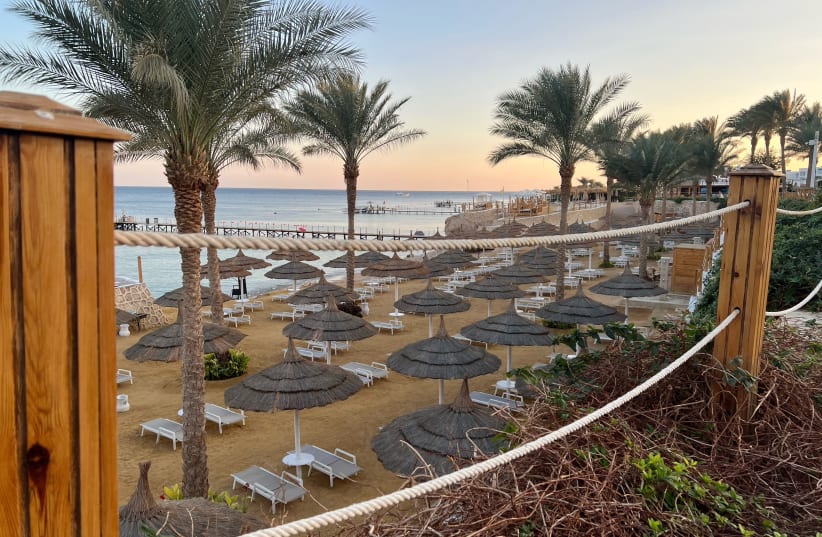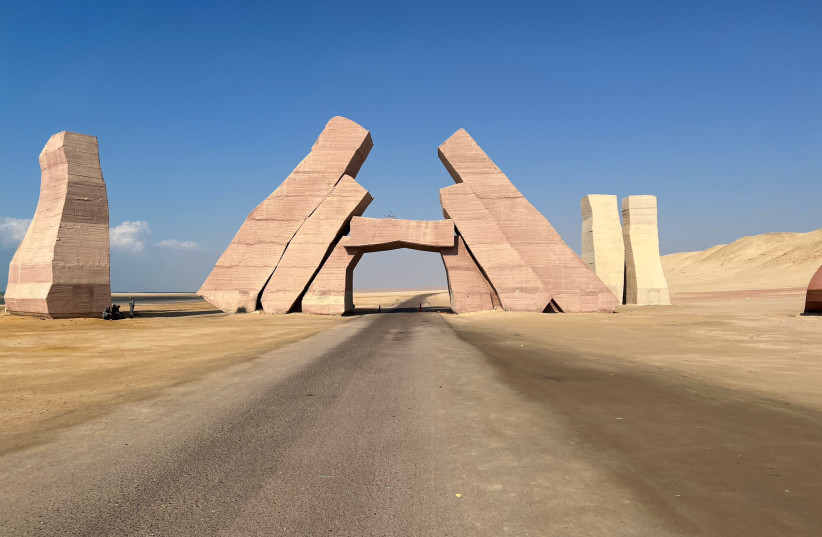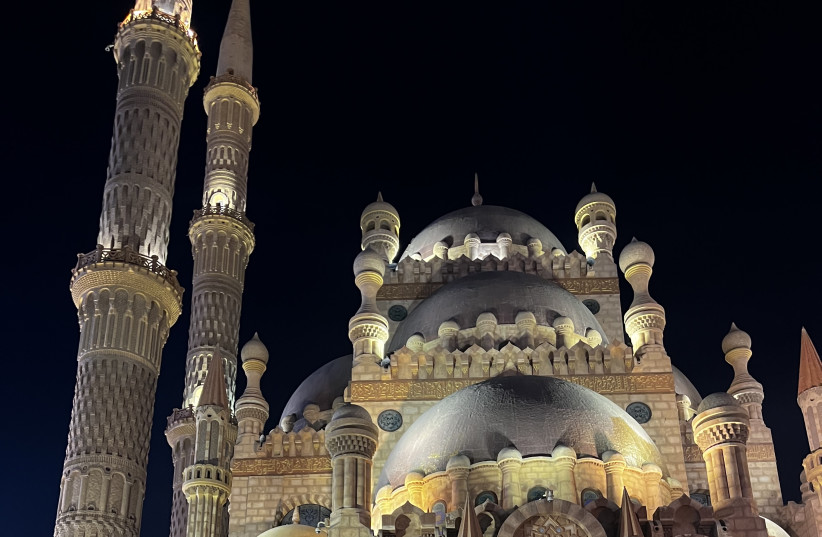In 2005, my family and I spent a week touring Egypt. We started in Cairo, where we visited the pyramids, the Sphinx and the Egyptian Museum. Then took the night train to Luxor to explore the exquisite tombs in the Valleys of the Kings and Queens, before finishing up in Aswan with a felucca [wooden sailing boat] ride on the Nile and a tour of Elephantine Island with its ancient Jewish presence.
Throughout the trip, we interacted with Egyptian merchants, restaurateurs, tour guides and drivers.
One thing we were warned to never mention was that we were Israeli.
Our guide in Cairo, Ahmed, was a lovely man – personable and great with the kids, who were preteens at the time. We told him we were Jewish but not where we lived. When we finally spilled the Israeli hummus beans at the very end of the trip, he commented, disturbingly, “I enjoyed our time together, and you’re very nice people, but I really don’t like Israelis.”
Seventeen years later, we returned to Egypt, this time to Sharm e-Sheikh, the desert oasis that has arisen in the southern tip of the Sinai Peninsula.
Our reception as Israelis this time couldn’t have been more different.
When we were asked where we were from and we answered “Israel,” we were greeted warmly, often with a halting Hebrew “Baruch haba” (Welcome) or “Ma nishma?” (How are you?).
“We are so happy Israelis are returning to Sharm.”
Things we heard
“We are so happy Israelis are returning to Sharm,” we heard on more than one occasion.
That might be a reference to the fact that direct flights from Ben-Gurion Airport to Sharm e-Sheikh are now offered by several Israeli airlines. We flew El Al (via its Sun Dor subsidiary) outbound and returned on Israir.
Taking the plane to Sharm is not cheap – we paid almost $400 a ticket, including cancellation insurance and several checked bags for our party of six – but the hour-and-20-minute flight is much more convenient than driving to Eilat, waiting in the unpredictable line to cross the border at Taba, and then arranging for a three-hour taxi ride on twisty-turvy roads. All the more so if you’re traveling with a baby, as we were.
SHARM E-SHEIKH is nearly exclusively a tourist town. It didn’t even exist before the Israelis established the Ofira settlement there in 1969. Israel left Sharm in 1982, following the Camp David Accords. Unlike Sinai’s other well-known settlement, Yamit, which was demolished, Ofira remains intact and is now home to local Egyptian residents.
In contrast to Sinai hot spots – such as Dahab and Nueiba with their budget-friendly “hut-on-the-beach” vibes popular with young Israelis – Sharm e-Sheikh, which stretches for some 20 km., is chock-a-block filled with sprawling resorts. The top of the line is the Four Seasons, but you can get good value for money at one of the properties in the Sunrise chain.
The five-star Sunrise Montemare Grand Select, where we stayed, runs around $150 a night per room, for bed and breakfast. In Eilat, on the Israeli side of the border, a similar hotel would be at least double that price.
The Montemare, like many Sharm resorts, is built on a hill. As you walk down from the reception area to the beach, you’ll pass six large pools – some heated, one with water slides – and enough lounge chairs so that none of the guests in the property’s 280 rooms ever feels crowded out.
The resort used to be for adults only, but when COVID decimated the travel business (tourism to Sharm was down some 70% in 2020), the Montemare and its sister Sunrise properties opened up to kids. There’s a nice playground with climbing structures, a Kids’ Planet with activities for four- to 12-year-olds, and even a kids’ disco every evening. Don’t want to climb back from the beach to your room with a tired toddler? There’s a free shuttle bus that comes by every 10 minutes.
The breadth of the breakfast buffet was on par with the typical Israeli morning feast – although, spoiler alert, you don’t go to Sharm for the food, which was decidedly bland and, aside from a small corner with falafel and fava beans, catered more to international than local tastes.
Sharm e-Sheikh’s bread-and-butter visitors are Europeans, for whom the promise of mild temperatures in the midst of winter has proven enticing. Russian is the primary language heard (the evening entertainment at our resort was entirely in that Slavic tongue), although since the war in Ukraine, travel from that part of the world has dropped – perhaps another reason the local merchants were so happy to greet us as Israelis.
Putin’s war has been tough for Sharm tourism for another reason: Flights from Russia only restarted in 2021 after a six-year ban following the 2015 downing of a Russian aircraft by the Sinai branch of ISIS, killing all 224 passengers and crew.
ALTHOUGH WE spent most of our time at the Montemare hanging out by the pool with the baby, there’s plenty to do in Sharm itself – at least for a few days (I wouldn’t recommend staying more than a week, tops).
The Old Market has gift shops and restaurants, although given that Sharm only really got going in 1982, it can hardly be considered “old.” The area is dominated by the iconic Sahaba Mosque, which is free to visit.
Nearby Na’ama Bay (developed by the Israelis prior to 1982) has the same kinds of shops and eateries but without the bargaining endemic to the Old Market. Another shopping sector, Soho Square, is an upscale Las Vegas-style mall, complete with a musical fountain, although it pales in comparison to the Bellagio’s dancing waters in Las Vegas.
One benefit of our resort’s location was that it was within walking distance of the Pickalbatros Aqua Park, which boasts more than 50 different water slides for all ages and has been dubbed “the largest in the Middle East.” Even the baby got a turn on his mother’s lap on one of the kiddie shoots. The $40 per person entrance fee includes lunch and unlimited ice cream and soft drinks.
Sharm’s main attraction, of course, is what’s under the water – the snorkeling and diving are among the world’s best. We booked a half-day tour to Ras Muhammad National Park, just 30 minutes south of our resort, and the fish and coral were the best I’ve ever seen. (Tiran Island, which we didn’t visit, reportedly has the wildest, most colorful reefs.)
The water in the Red Sea in the winter is cold, so we rented wet suits. Our snorkeling guide pulled a floating ring that we clung to, so no one got lost as we ventured farther out into the sea. You can visit Ras Muhammad by boat or land; the snorkeling areas are very close to the shore. We opted for the latter ($35 per person, gear extra).
It was a windy day when we visited Ras Muhammad, and the waves were pretty choppy. As I was attempting to get out of the water, I removed my flippers and suddenly felt intense pain. Hoisting myself onto the beach, I gazed down at my foot, horrified. I must have gotten cut on some coral. The gash was deep, red and filled with sand and debris.
Back at the tour van, a plethora of drivers and guides tended to me, cleaning and wrapping the wound. One driver who spoke no English repeatedly patted me on the shoulder. It was surprisingly comforting.
The cut required four stitches and a week’s course of penicillin. But the worst part: I couldn’t go back into any of the resort’s pools, let alone the Aqua Park. We had considered an excursion to Mount Sinai and the Saint Catherine Monastery, but my injured appendage put the kibosh on that, too.
FOR VISITORS to Sharm e-Sheikh worried about COVID, my advice: Don’t go. We saw zero masks our entire time there – literally zero. Fortunately, this is an outdoorsy town, and the weather was comfortable enough, even at night, to eat mostly al fresco.
Sharm e-Sheikh was the host of the recent COP27 UN Climate Change conference – an ironic location, since Sharm has no public transportation, and its desert setting means that most everything visitors need must be flown or trucked in. But the presence of high-profile delegations just a few weeks prior meant the place was spruced up and spotless.
The reception we received as Israelis was reminiscent of our experience visiting Dubai earlier this year – another Arab country welcoming its Jewish neighbors. It makes good business sense. Do we agree on politics? Probably not, but it never came up.
The hospitality and service are topnotch, the prices reasonable, and with fast flights, it’s relatively close to home.
Just watch out for the coral. It cuts equally, regardless of nationality.
If you go…
In 2019, some 1.4 million Israelis crossed into Sinai by car, according to the Israel Airports Authority, which oversees the Taba border, the main way into Sinai from the southern Israeli town of Eilat. Those numbers took a hit during the COVID-19 pandemic, with just 335,436 travelers making the journey in 2021, AP reported. However, in 2022, the same number of tourists entered through the Taba crossing in just the first six months of the year, heralding a return to normal.
The overland crossing is popular but can be erratic, with wait times at Taba ranging from an hour to triple or more than that during high season. Except for the rare exception, most Israelis drive to Eilat, park their cars on the Israeli side of the border and take a taxi to their Sinai destination. After Taba comes Nueiba (an hour and 15 minute drive), Dahab (two hours) and Sharm e-Sheikh (three hours).
Direct flights from Ben-Gurion Airport began in April 2022. El Al’s Sundor subsidiary. Israir and Arkia all service the route. Expect to pay between $150 and $400 round-trip, depending on the season and whether you can travel with just a carry-on and no cancellation protection. The flights take an hour and 20 minutes, so even with the time to get to the airport in Tel Aviv in advance and collect luggage afterward in Sharm, it’s still much faster than the long drive and potentially longer wait.
Egypt grants visitors to the Sinai a 14-day visa for free as long as they stay in Sinai and don’t continue on to Egypt proper. Want to take the bus from Sinai to Cairo? Add $25 for a single-entry visa, $60 for multiple entries. Visas are issued on the spot at the airport in Sharm e-Sheikh or at the Taba border crossing.
There are hundreds of resorts in Sharm e-Sheikh, ranging from budget places to over-the-top luxurious. The Sunrise and Pickalbatros chains offer excellent value for money. The latter includes Sharm’s top water park, which bumps up the price a bit. The Rixos is an adult-only (18 and up) property. Most resorts offer an all-inclusive all-you-can-eat option; but our advice (unless you enjoy gorging out on mediocre meals) – choose just the bed and breakfast plan, and dine out at a more authentic restaurant in the Old Market, Soho Square or Na’ama Bay.


